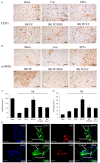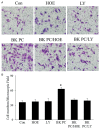Transplantation of bradykinin-preconditioned human endothelial progenitor cells improves cardiac function via enhanced Akt/eNOS phosphorylation and angiogenesis
- PMID: 26328006
- PMCID: PMC4548314
Transplantation of bradykinin-preconditioned human endothelial progenitor cells improves cardiac function via enhanced Akt/eNOS phosphorylation and angiogenesis
Abstract
This study determines whether preconditioning (PC) of human endothelial progenitor cells (hEPCs) with bradykinin promotes infarcted myocardium repair via enhanced activation of B2 receptor (B2R)-dependent Akt/eNOS and increased angiogenesis. hEPCs with or without bradykinin preconditioning (BK-PC) were transplanted into a nude mouse model of acute myocardial infarction. Survival of transplanted cells was assessed using DiD-labeled hEPCs. Infarct size, cardiac function, and angiogenesis were measured 10 d after transplantation. Akt, eNOS, and vascular endothelial growth factor (VEGF) expressions in cardiac tissues were detected by western blotting, and NO production was determined using an NO assay kit. The cell migration and tube formation in cultured hEPCs were determined using transwell chamber and matrigel tube formation assays, respectively. The VEGF levels in the cell supernatant were measured using an enzyme-linked immunosorbent assay kit. BK-PC-hEPCs improved cardiac function, decreased infarct size, and promoted neovascularization 10 d following transplantation. PC increased Akt and eNOS phosphorylation, VEGF expression, and NO production in the ischemic myocardium. The effects of BK-PC were abrogated by HOE140 (B2R antagonist) and LY294002 (Akt antagonist). PC increased hEPC migration, tube formation, and VEGF levels in vitro. Activation of B2R-dependent Akt/eNOS phosphorylation by BK-PC promotes hEPC neovascularization and improves cardiac function following transplantation.
Keywords: Bradykinin; endothelial progenitor cells; myocardial infarction; neovascularization; preconditioning.
Figures






Similar articles
-
Transplantation of bradykinin-preconditioned human endothelial progenitor cells improves cardiac function via enhanced Akt/eNOS phosphorylation and angiogenesis.Am J Transl Res. 2015 Jun 15;7(6):1045-57. eCollection 2015. Am J Transl Res. 2015. PMID: 26279749 Free PMC article.
-
Bradykinin preconditioning improves therapeutic potential of human endothelial progenitor cells in infarcted myocardium.PLoS One. 2013 Dec 2;8(12):e81505. doi: 10.1371/journal.pone.0081505. eCollection 2013. PLoS One. 2013. PMID: 24312554 Free PMC article.
-
Bradykinin Protects Human Endothelial Progenitor Cells from High-Glucose-Induced Senescence through B2 Receptor-Mediated Activation of the Akt/eNOS Signalling Pathway.J Diabetes Res. 2021 Sep 11;2021:6626627. doi: 10.1155/2021/6626627. eCollection 2021. J Diabetes Res. 2021. PMID: 34557552 Free PMC article.
-
Tissue kallikrein-modified human endothelial progenitor cell implantation improves cardiac function via enhanced activation of akt and increased angiogenesis.Lab Invest. 2013 May;93(5):577-91. doi: 10.1038/labinvest.2013.48. Epub 2013 Mar 18. Lab Invest. 2013. PMID: 23508045 Free PMC article.
-
Role of kinins in the pathophysiology of myocardial ischemia. In vitro and in vivo studies.Diabetes. 1996 Jan;45 Suppl 1:S51-8. doi: 10.2337/diab.45.1.s51. Diabetes. 1996. PMID: 8529801 Review.
Cited by
-
MicroRNA-195 regulates proliferation, migration, angiogenesis and autophagy of endothelial progenitor cells by targeting GABARAPL1.Biosci Rep. 2016 Oct 14;36(5):e00396. doi: 10.1042/BSR20160139. Print 2016 Oct. Biosci Rep. 2016. PMID: 27623937 Free PMC article.
-
Adipose-Derived Stem Cells: Angiogenetic Potential and Utility in Tissue Engineering.Int J Mol Sci. 2024 Feb 16;25(4):2356. doi: 10.3390/ijms25042356. Int J Mol Sci. 2024. PMID: 38397032 Free PMC article. Review.
-
Genetically modified endothelial progenitor cells with hNotch1.ICN overexpression display facilitated angiogenesis.Ann Transl Med. 2020 Oct;8(20):1316. doi: 10.21037/atm-20-6362. Ann Transl Med. 2020. PMID: 33209896 Free PMC article.
-
Expression of B2 Receptor on Circulating CD34-Positive Cells and Outcomes of Myocardial Infarction.Dis Markers. 2019 Jul 8;2019:7816438. doi: 10.1155/2019/7816438. eCollection 2019. Dis Markers. 2019. PMID: 31360266 Free PMC article.
-
Effects of bradykinin on the survival of multiterritory perforator flaps in rats.World J Surg Oncol. 2019 Feb 27;17(1):44. doi: 10.1186/s12957-019-1570-3. World J Surg Oncol. 2019. PMID: 30813916 Free PMC article.
References
-
- Ferrara N, Kerbel RS. Angiogenesis as a therapeutic target. Nature. 2005;438:967–974. - PubMed
-
- Annex BH. Therapeutic angiogenesis for critical limb ischaemia. Nat Rev Cardiol. 2013;10:387–396. - PubMed
-
- Taljaard M, Ward MR, Kutryk MJ, Courtman DW, Camack NJ, Goodman SG, Parker TG, Dick AJ, Galipeau J, Stewart DJ. Rationale and design of Enhanced Angiogenic Cell Therapy in Acute Myocardial Infarction (ENACT-AMI): the first randomized placebo-controlled trial of enhanced progenitor cell therapy for acute myocardial infarction. Am Heart J. 2010;159:354–360. - PubMed
-
- Yu P, Li Q, Liu Y, Zhang J, Seldeen K, Pang M. Pro-angiogenic efficacy of transplanting endothelial progenitor cells for treating hindlimb ischemia in hyperglycemic rabbits. J Diabetes Complications. 2015;29:13–19. - PubMed
LinkOut - more resources
Full Text Sources
